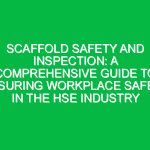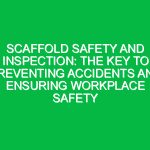Working in the Health Safety and Environment (HSE) industry involves a lot of risks, especially when it comes to working at heights. Scaffold safety and inspection are crucial aspects of ensuring workplace safety in this industry. By following proper guidelines and procedures, companies can prevent accidents and injuries that can result from using scaffolds incorrectly. In this article, we will discuss the importance of scaffold safety and inspection and provide a comprehensive guide on how to ensure workplace safety in the HSE industry.
The Importance of Scaffold Safety
Scaffolds are temporary structures used to support workers and materials during construction, maintenance, and repair work. They are essential in the HSE industry, as they provide a safe working platform for workers who need to perform tasks at heights. However, if scaffolds are not properly installed, maintained, or used, they can pose serious risks to workers’ safety.
According to the Occupational Safety and Health Administration (OSHA), falls from scaffolds are one of the leading causes of injuries and fatalities in the construction industry. To prevent accidents and injuries, companies must prioritize scaffold safety by conducting regular inspections and ensuring that workers are trained on how to use scaffolds safely.
The Scaffold Inspection Process
Before using a scaffold, it is essential to conduct a thorough inspection to ensure that it is safe for use. Here are some key steps to follow during the scaffold inspection process:
- Inspect the scaffold before each use, as well as after any modifications or repairs.
- Check for any visible defects, such as missing or damaged components, loose connections, or signs of corrosion.
- Ensure that all components are securely fastened and that the scaffold is stable and level.
- Check the weight capacity of the scaffold to ensure that it can support the load it will carry.
- Verify that guardrails, midrails, and toeboards are in place to prevent falls.
Ensuring Workplace Safety
To ensure workplace safety in the HSE industry, companies must develop and implement a comprehensive scaffold safety program. This program should include the following elements:
- Training: All workers who will be using scaffolds must receive proper training on how to set up, use, and dismantle scaffolds safely.
- Inspections: Regular inspections should be conducted to identify and address any potential hazards or defects in the scaffolds.
- Documentation: Keep detailed records of scaffold inspections, repairs, and maintenance activities to ensure compliance with safety regulations.
- Communication: Ensure that workers are aware of the risks associated with working on scaffolds and encourage them to report any safety concerns.
- Supervision: Assign a competent person to oversee scaffold activities and ensure that all safety procedures are being followed.
Summary of Key Points
In conclusion, scaffold safety and inspection are essential components of ensuring workplace safety in the HSE industry. By following proper guidelines and procedures, companies can prevent accidents and injuries that can result from using scaffolds incorrectly. To ensure workplace safety, companies must prioritize scaffold safety by conducting regular inspections, providing proper training to workers, and implementing a comprehensive safety program. By taking these steps, companies can create a safe working environment for their employees and reduce the risks associated with working at heights.


